The
Grapes of Wrath {1940}
Director : John Ford
From the novel by John Steinbeck
While the denizens of New York were coping with all that the
Depression brought about, thousands of miles to the west and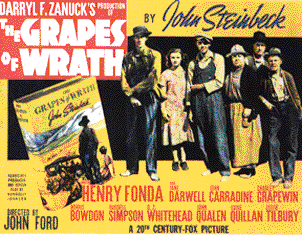 half a continent away the misery of the farmers of the mid-west was
compounded tenfold by a series of natural disasters.
half a continent away the misery of the farmers of the mid-west was
compounded tenfold by a series of natural disasters.
John Steinbeck's monolithic opus written in 1939 relates the
devastating effect of the Dust Bowl through the trials and
tribulations of the Joad family. The Joads are fictional but represent
a typical mid-west family whose sole source of sustenance is from the
land. Steinbeck's painstaking research on the subject led him to
travel the migrant road where he met several migrant families and
visited so-called Labor Camps----add the fact that he was writing as
the story unfolded and there is an unmistakeable documentary feel to
the book.
For a better appreciation of both film and book it's essential to know
something of the background to the story which has its origins in
1895, the time of the last great land rush, when thousands of
land-seekers raced across the plains to stake out a claim on the best
piece of land they could find. The plains consisted of hundreds of
species of natural grasses and each of the settlers removed a portion
and planted corn and cotton in an effort to become self-sustaining.
What they didn't know was that the grasses had been binding the soil
to the land for millennia and removing them altered a delicate balance
and left the land vulnerable to the forces of nature ---add to this
medieval farming methods and the mid-west was a disaster waiting to
happen. A scant forty years later that disaster came about and when it
arrived the consequences were Biblical in proportion ; a decade of
drought was followed by high winds and the soil simply blew away. The
effects left thousands facing not only financial ruin but the stark
reality of famine and so they walked, drove or rode away from the
devastated land and the great trek to California began.
John Ford has faithfully retained the essence of Steinbeck's epic and
the movie inevitably also has a documentary edge to it emphasised by
the grainy black and white film. The usual humourous asides that Ford
injected into most of his films is absent from "Grapes" with
a distinct lack of action and no happy ending to the Joad odyssey
---so be warned that you need to be in the mood for some heavy realism
or a historian of the Dust Bowl to enjoy this film. John Carradine
brings his usual gravitas to the role of Casy and Henry Fonda made the
role of Tom Joad his own among the plethora of character actors who
make up the migrant families.
Steinbeck never denied that his novel was also an allegory based upon
every migrant that ever travelled the continent in search of the
American Dream and he went so far as to declare that it could even be
seen as an allegory upon the struggles of mankind to reach its
destiny. There are many Biblical references such as the vision of
California as the Promised Land and there are elements of the same
thing throughout the film.
The Dust Bowl days have entered into American folk-lore and are
recalled in song and story by Woody Guthrie, Merle Haggard, Nanci
Griffith and many others. There is an understandable penchant to
romanticize the story and translate the travails of the migrants into
a heroic odyssey but the truth is that it was a time of desperate
poverty and unimaginable hardship and there is very little dignity in
any of that.
The film was lauded to the skies by critics and audiences alike and
Oscars were scattered around like confetti ---- the sad thing was that
the subjects of the film were unable to afford a ticket to see it.
If you have ever wondered at the origin of the curious title to
Steinbeck's novel it was chosen by his wife Carol who extracted the
words from a line in The Battle Hymn of The
Republic.
The Natural
{ 1984 }
Director : Barry Levinson
From the novel by Bernard Malamud
The Natural is the
quintessential homage to 1930's America, combining small-town
aspirations, a real feel for the period and not least the Golden Age
of baseball when it was still the "people's game". When it
comes to baseball, Americans have romanticized their national sport to
such a degree that it has come to have a mythical quality and in
regard to the  athletes, athletes,  their
feats are spoken of in awe while they themselves have been almost
deified. The excellent Field of Dreams
is the perfect example of the mystique and The
Natural while not so overt has been
invested with a similar mystical quality. Roy Hobbs { played by Robert Redford } is the fictional embodiment of Shoeless
Joe, Babe Ruth, Lou Gehrig, Ty Cobb and all the other fabled players
whose legends grow more Olympian with the passing of each year . their
feats are spoken of in awe while they themselves have been almost
deified. The excellent Field of Dreams
is the perfect example of the mystique and The
Natural while not so overt has been
invested with a similar mystical quality. Roy Hobbs { played by Robert Redford } is the fictional embodiment of Shoeless
Joe, Babe Ruth, Lou Gehrig, Ty Cobb and all the other fabled players
whose legends grow more Olympian with the passing of each year .
Hobbs plays his baseball in the fields of his home town and carves his
bat, Wonderboy, from the wood of a tree struck by lightning which is
not quite Excalibur standard but is in the same vein. His first
introduction to big-league baseball is via The Whammer, a legendary hitter played by Joe Don Baker in his usual
ebullient style who Hobbs meets and defeats while on his way to
Chicago to try out for the big league. At this point we could be excused for
believing that the film would follow the pleasant but well-worn path
of country boy making good in the big city with all the standard
clichés ---but not so ; meeting a
good-looking girl { Barbara Hershey } on the train, Hobbs accompanies
her back to her apartment where she
suddenly turns around and shoots him for no reason whatsoever.
The clues were there for both Hobbs and myself to be on guard for such
a situation but I don't know who was more shocked when the shot rang
out, him or me. It's at
this point that you sit up and take note that this is no conventional
sports film.
In one act of random and pointless violence Hobbs has been robbed of
his dream and although he recovers he has also  been robbed of his
youth and the next time we see him he is making the same journey 16
years later. been robbed of his
youth and the next time we see him he is making the same journey 16
years later.
In the face of almost insurmountable odds, Hobbs then begins where he
left off to eventually become the legendary hitter that he always
wanted to be and the mystical ethos becomes pervasive as his strikes
become awesome to behold as they break clocks, break records and break
bats, often to a background of thunder and lightning.
You don't have to be a baseball fan to enjoy the film although it does
enhance the experience I imagine but The
Natural is about lost dreams and
ambitions and wasted talent. The triumph of the film and the essence
of the story is that Hobbs refuses to let his dreams die and his
talent wither, no matter what, and in a glorious finale of fireworks
set to a background of thunder and lightning he wins back both his
talent and his girl that were taken from him so many years before.
Robert Duvall, Glenn Close and Kim Basinger are worth the price of
admission alone to see The Natural
which for once is far superior than its source material, Bernard
Malamud's rather plodding novel.
There's a nice little touch when the two coaches in the dug out
alternate at humming a song and challenging each other to put a name to it. The director had spotted the pair doing just that
between takes and filmed them without their knowledge.
Dick Tracy [
1990 }
Director : Warren Beatty
Despite the impressive cast list it still took an
awesome amount of optimism to produce Dick
Tracy, the film. Chester
Gould's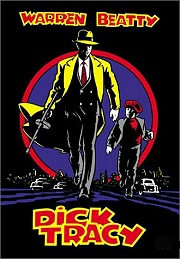 lantern-jawed detective was born in the 30's as a counterpoint to the
crime-wave going on at the time and he was enormously popular in the
dailies and later in comic-book format. The first Tracy appeared in
1931 and was a household name throughout the 40's, 50's and even up to
the 70's, slowly falling into decline as a more sophisticated audience
demanded more 3-dimensional heroes. Today Tracy is not without his
hard-core fans but to the greater part of the population if they have
heard of him at all it is as an anachronistic cartoon character
quietly fading into comic-book history. It was therefore an Olympian
leap of faith by Warren Beatty to resurrect a character so virtuous
and without blemish in an age of cynicism and so-called
sophistication.
lantern-jawed detective was born in the 30's as a counterpoint to the
crime-wave going on at the time and he was enormously popular in the
dailies and later in comic-book format. The first Tracy appeared in
1931 and was a household name throughout the 40's, 50's and even up to
the 70's, slowly falling into decline as a more sophisticated audience
demanded more 3-dimensional heroes. Today Tracy is not without his
hard-core fans but to the greater part of the population if they have
heard of him at all it is as an anachronistic cartoon character
quietly fading into comic-book history. It was therefore an Olympian
leap of faith by Warren Beatty to resurrect a character so virtuous
and without blemish in an age of cynicism and so-called
sophistication.
Warren Beatty must have called in an awful lot of debts to assemble
the impressive cast list --- if you don't blink you can even spot
Kathy Bates as a stenographer and James Caan who lasts about 30
seconds. Why Beatty ever needed such big names is a mystery because
most of them are unrecognisable beneath the thick layers of make-up
required to shape the bizarre characters that inhabit Tracy's
universe. Al Pacino is just about recognisable as Big Boy Caprice,
Dustin Hoffman incomprehensible as Mumbles, Estelle Parsons and
Michael.J.Pollard { both from Bonnie and Clyde } have cameos along
with Paul Sorvino and Willam Forsythe and believe it or not even Dick
Van Dyke is in there somewhere. Madonna has a great time vamping it up
and upsetting Tracy's girlfriend Tess Trueheart { what a great name
that is } and she manages to slip in a few numbers here and there ---surprise,surprise.
The sets an d
backgrounds to the film consist of a surreal city seen mostly at night
in which vari-coloured lights blink on and off giving an almost
fairyland effect while all of the indoor scenes have garish and
glossed furniture in every room. I can only imagine that the idea is a
substitute for a cartoon background and in its way it very effective
but combined with the musical interludes it makes the experience more
theatrical than cinematic. d
backgrounds to the film consist of a surreal city seen mostly at night
in which vari-coloured lights blink on and off giving an almost
fairyland effect while all of the indoor scenes have garish and
glossed furniture in every room. I can only imagine that the idea is a
substitute for a cartoon background and in its way it very effective
but combined with the musical interludes it makes the experience more
theatrical than cinematic.
Warren Beatty takes off Tracy with his usual panache which on this
occasion he needs in spades playing the straightest of straight arrows
and resisting the wiles of Breathless Mahoney with ease. And he must
have had a wry smile whenever he used his wrist radio which was the
cutting edge in detection back then.
Dick Tracy is a great tribute to a long-forgotten character in the
30's and is never anything less than enjoyable and whatever it's
failings Warren Beatty must be applauded for attempting something
completely different but the overall impression is of a film with far
more style than substance. There are some who have described its
Director in the very same way.
The
Rocketeer { 1991 }
Director: Joe Johnston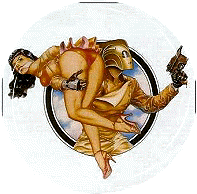
When Dave Steven's Rocketeer first went on
sale in the late 1980's, comic-book aficionados immediately recognized
a new star in the fi rmament
and the first issue sold like hot cakes. Right from the word
go, Rocketeer built up a solid fan-base and there was every
reason to believe that a new super-hero on a par with the all-time
greats was about to take off. Even readers new to comic- books
could appreciate that the beautifully drawn lines had been crafted
with loving care and an attention to detail. The stage was set
for Rocketeer
and Dave Stevens to enter the comic-book Hall of Fame
and a breathless audience awaited the second issue with a
multitudinous tapping of impatience. Months went by and the
second issue was still to appear on the newsstands with rumours of
publishing problems the cause. There was some truth in the
publishing problems but the real reason, as fans were soon to
discover, was that Dave Stevens was tortuously slow in producing his
work and he was soon to become notorious for his tardiness. The
first series was eventually
completed after many months and an event which must be unprecedented
in comic-book publishing took place whereby each issue emerged
published by a different publisher --- starting with Comico and
Pacific through Eclipse and onto Dark Horse. Even when the film
had gone into production Stevens was still finalising sections of the
graphic novel which was it's inspiration. rmament
and the first issue sold like hot cakes. Right from the word
go, Rocketeer built up a solid fan-base and there was every
reason to believe that a new super-hero on a par with the all-time
greats was about to take off. Even readers new to comic- books
could appreciate that the beautifully drawn lines had been crafted
with loving care and an attention to detail. The stage was set
for Rocketeer
and Dave Stevens to enter the comic-book Hall of Fame
and a breathless audience awaited the second issue with a
multitudinous tapping of impatience. Months went by and the
second issue was still to appear on the newsstands with rumours of
publishing problems the cause. There was some truth in the
publishing problems but the real reason, as fans were soon to
discover, was that Dave Stevens was tortuously slow in producing his
work and he was soon to become notorious for his tardiness. The
first series was eventually
completed after many months and an event which must be unprecedented
in comic-book publishing took place whereby each issue emerged
published by a different publisher --- starting with Comico and
Pacific through Eclipse and onto Dark Horse. Even when the film
had gone into production Stevens was still finalising sections of the
graphic novel which was it's inspiration.
Dave Stevens work can be seen in various publications such as Alien
Worlds, Airboy
and various pieces of good-girl art but he never seems
to stay long with any one theme and he is a collector's nightmare with
art and stories scattered here, there and everywhere. It has to
be accepted that Steven's is anything but prolific but at the same
time he has never strayed from the excellence that is his hallmark and
he will always be identified with the character he created --the Rocketeer.
Joe Johnston is obviously as much a fan of the Rocketeer
because he
has directed the film with the same loving care and eye for detail
that Stevens applied to the comics. With an eclectic mix of now
vintage motor-bikes, Gee Bee planes, Howard Hughes, Nazi spies,
Zeppelins, gangsters, handsome heroes and those singular 30's cuties,
Johnston has brought Steven's pages to life.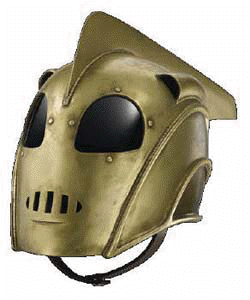
Bill Campbell plays Cliff Secord, more interested in his flying than
his beautiful and feisty girl-friend Jenny played by Jennifer Connelly
{ later to appear in A Beautiful Mind } while Alan Arkin as Cliff's
mechanic looks for all the world like Gepeto come to life. Bringing up the
rear as the villains are Paul Sorvino, a mafioso loyal to America, the
gigantic Tiny Ron as Lothar and Timothy Dalton as the oily movie-star/
Nazi agent.
The stubby Gee Bee planes were racing monoplanes in the 1930's and set
several speed records ---252 mph was one such.
Although it does not appear in Steven's books, Johnston has Cliff
escaping via Howard Hughes Spruce Goose.
Dave
Stevens freely acknowledges that his inspiration for Rocketeer was a
Saturday-Matinee serial called King of the Rocketmen and Joe Johnston
has captured perfectly that unique innocence and escapism which
epitomises the era of the Saturday-Matinee serials.
Billy
Bathgate
{ 1991 }
Director : Robert Benton
Novel by : E.L.Doctorow
It could be argued that Billy Bathgate should be in the Gangster
page but although the film is undoubtedly about gangsters like all of
Doctorow's novels it is more an affectionate nod to the era ---hence
it's placing here. It has to be said from the start that as
enjoyable as it is, the movie is more quirky than a classic of the genre
but it has a certain eccentric charm all of its own despite all its many
faults.
 The
teenaged Billy Bathgate { Loren Dean } admires Dutch Schultz and his
gangster entourage and is flattered when Schultz gives him a small part
in the organization. Billy soon notices that the affable
Schultz has a volcanic temper triggered by the slightest setback and
behind the amiable facade there is a ruthless and cruel killer.
Dutch Schultz is played by Dustin Hoffman in a performance so over the
top that it sometimes teeters on the brink of being comical. The
mood swings that he adopts are so extreme as to paint a picture of
someone verging on a total breakdown ---- but on reflection, Hoffman's
astonishing performance could be said to be a brilliant portrayal of a
homicidal maniac. So, you pays your money and you takes your
choice and one thing's for sure ---it's never boring. The
teenaged Billy Bathgate { Loren Dean } admires Dutch Schultz and his
gangster entourage and is flattered when Schultz gives him a small part
in the organization. Billy soon notices that the affable
Schultz has a volcanic temper triggered by the slightest setback and
behind the amiable facade there is a ruthless and cruel killer.
Dutch Schultz is played by Dustin Hoffman in a performance so over the
top that it sometimes teeters on the brink of being comical. The
mood swings that he adopts are so extreme as to paint a picture of
someone verging on a total breakdown ---- but on reflection, Hoffman's
astonishing performance could be said to be a brilliant portrayal of a
homicidal maniac. So, you pays your money and you takes your
choice and one thing's for sure ---it's never boring.
Billy's life is further complicated when he falls for Schultz's moll
played by the sultry Nicole Kidman practicing for the even better roles
which were to follow. Steve Buscemi as one of the gangster's
henchmen sadly has few lines. Billy is never suited for the
gangster way of life and he stumbles through plots and counterplots and
assassinations somehow surviving his strange rite of passage coming out
the other side chastened and lucky to be alive.
One of the firmly entrenched staples of the gangster genre has always
been the feet-in-cement swim in the East River but I can't recall a
single film in which I have seen the performance even hinted at apart
from a hilarious Laurel and Hardy when a circular cement bowl has them
rocking but not falling over the dockside like life-size Subbuteo men. So, it's a bit of a
surprise when we come across Bruce Willis in his best suit and his feet
in a bowl of cement and if you have seen the Laurel and Hardy film then
it's difficult to take this quite pivotal part of the film seriously.
Never a great movie and never did well at the box office but certainly
not to be dismissed and unusual to say the least.
It
goes without saying that the Indiana
Jones movies can only be
spoken of in superlatives and have been so many times that I have
omitted to repeat here what so many have said previously.
They are the supreme homage to the Saturday Matinee and
exemplify all the adventure and freshness of the 30’s period and
require no introduction whatsoever.
Forever
Young
( 1992 )
Director
: Steve Miner
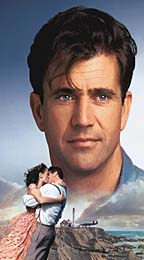 Set
initially in the late 30's and onwards into the 40's and 50's, Mel
Gibson as Captain Daniel McCormick switches quite easily between
carefree, careworn and comic in a film in which he is able to utilise
the full repertoire of his acting ability. The film runs a whole
gamut of emotions from romantic comedy which is displaced by tragedy
which in its turn is replaced by drama. One of the most emotive
episodes in the whole film is via one of these sudden changes in mood
when we are enjoying Daniel and his girlfriend's light-hearted love
affair almost as much as they are and tragedy strikes unexpectedly and
suddenly as it always does and Daniel is devastated to see his girl
run over by a car. Set
initially in the late 30's and onwards into the 40's and 50's, Mel
Gibson as Captain Daniel McCormick switches quite easily between
carefree, careworn and comic in a film in which he is able to utilise
the full repertoire of his acting ability. The film runs a whole
gamut of emotions from romantic comedy which is displaced by tragedy
which in its turn is replaced by drama. One of the most emotive
episodes in the whole film is via one of these sudden changes in mood
when we are enjoying Daniel and his girlfriend's light-hearted love
affair almost as much as they are and tragedy strikes unexpectedly and
suddenly as it always does and Daniel is devastated to see his girl
run over by a car.
The cryogenics machine is a marvel of 30's engineering while the
idea of a 30's man transplanted several decades into the future is
intriguing and even in such a short time-span Daniel has problems
adjusting to the technological and social changes. Typical of
many 30's movies there is a nostalgic nod to the aircraft of the
times.
Some of the scenes between Mel Gibson and Elijah Wood ( playing the 10
year old Nat Cooper ) are also touching while the scene between
Nat's Mum, Claire ( Jamie Lee Curtis ) is guaranteed to bring the
Kleenex out. In this scene, Claire insists upon playing Billie
Holiday's hauntingly beautiful "The Very Thought of
You"
( which plays throughout the film ) and Daniel breaks
down ---a very sensitively done scene.
But throughout it all the film is shot through with a
wry and subtle humour and like all good comedy there is an underlying
sadness taking in the transience of youth, the bitterness of age and
the endurance of love. It makes you laugh and it makes you cry
---- just like life itself.
Sky
Captain and the World of Tomorrow
{ 2004 }

Director : Kerry Conran
All the elements of 30’s kitsch are present in Sky Captain ------
mad scientists, Nazi spies, fiendish Orientals, death rays and so on
---- but despite the obvious effort gone into the film it just does
not work. The beginning
is quite promising with a beautifully painted art-deco New York and
the attack of the giant robots but things go downhill rapidly after
that and it never fulfils its initial promise.
It
has become almost de rigeur in this type of film to have a
laugh-in-the-face-of-danger All-American daredevil and his sexy and cute-but- feisty,
girl-next-door girlfriend but Jude Law and
Gwyneth Paltrow just don’t have the pizzazz to carry it off
----sadly, they are both miscast and do not have that essential
chemistry between them. Also,
this type of role is totally unsuitable for British actors and Jude
Law in particular delivers his lines with no conviction whatsoever.
Even the appearance of a leather-clad Angelina Jolie can’t jerk Sky
Captain out of his inertia and by the time the credits began to role
everyone concerned looked relieved that it was all over.
As a parody of the Saturday afternoon Matinee it is a total failure
-as a true Saturday Matinee cliffhanger it’s great ------ but in the
knowledge that most kids these days can’t even find their way to
school never mind the cinema, the only World of Tomorrow that I can
envisage for Sky Captain and his pals is endless re-runs every
Christmas day until the world grows cold and is ruled by intelligent
woodlice.
The
Aviator (
2004 )
Director : Martin Scorsese
Despite a stellar cast and a renowned
director The Aviator
just doesn't capture the fantastic life of Howard Hughes and his
romances with aircraft, women and politics, lacking that certain
indefinable 30's ambiance. It's difficult to pin-point where the
film falls down and hardly fair to blame individuals but it has to be
said that Leonard de Caprio comes across as an insipid version of
Hughes and fails to capture the dynamic and mercurial nature of the
man. Similarly, Jude Law plays Errol Flynn in the same
manner and someone should have told Jude that nobody could play Errol
except Errol. Cate Blanchett makes a fist of playing Katherine
Hepburn but is hardly enough to carry the whole film.
Sadly, The Aviator
is
a missed opportunity to to make the definitive film about a 30's icon
and the film is frankly boring which is most unusual for a director of
Scorsese's quality and the subject matter.
Cinderella Man {
2005 }
Director : Ron Howard
 Just
as you might expect from a Ron Howard movie, Cinderella Man
is an
old-fashioned, straight-forward tale of a good man finding the
strength to face adversity and triumph over it. The man is
James.J.Braddock who resurrected a moribund career and literally
lifted himself off the canvas to become Heavy Champion of the World.
At that time, there was more cachet than cash in holding the title but
nevertheless it offered a means of escape from poverty. Just
as you might expect from a Ron Howard movie, Cinderella Man
is an
old-fashioned, straight-forward tale of a good man finding the
strength to face adversity and triumph over it. The man is
James.J.Braddock who resurrected a moribund career and literally
lifted himself off the canvas to become Heavy Champion of the World.
At that time, there was more cachet than cash in holding the title but
nevertheless it offered a means of escape from poverty.
Cinderella Man is as much about depression-era New York as it is about
boxing and the struggle to get by is underlined throughout the film. As
Braddock's boxing career goes into free-fall he is forced to earn
money any way that he can in order to feed his family and each morning
he faces the humiliation of jostling at the dock gates to be chosen
for a day's work { New York docks was not alone in carrying out this
humiliating procedure ----Liverpool { U.K.} dock workers were for many
years faced with the same ritual and labour negotiations were forever
after coloured by memories of those dreadful times }.
The gnawing futility of youth and vigour without employment and the
subsequent grinding poverty are explicit throughout and Braddock is no
stranger to the bread-line or claiming Poor Relief --- it's difficult
to believe that the verdant pastures of Central Park were once a tent
city full of refugees.
There is one particular scene which could have been culled straight
from a Jack London short story in which Braddock is about to go to a
fight and he gives one of his children his meal. Only Ron Howard knows
whether he took this from London's short story but the exact same
thing is the subject of London's "For Want of a
Steak".
A feature of many Ron Howard movies is the stirring grandstand finish
and Cinderella Man is no exception as Braddock slugs it out with Max
Baer to emerge as the new Heavyweight Champion against all the odds
----the " underdog" theme never fails to enthrall.
Despite the all-action ending and despite being immensely entertaining
Cinderella Man never really makes it as one of the great boxing movies
---there are too many flaws. Not least among these is Renée
Zellweger's pouting and posing which is highly irritating and
not in the least appropriate to this particular film ---she comes over
as Brigitte Jones, lost in time.
Although it's easy to believe that Braddock claimed Poor Relief what
is harder to believe is that he paid it all back when better times
came along. This was an unnecessary and superfluous addition to his
already flawless character in the film.
Finally, I can never understand why Madison Square Garden always looks
far more glamorous in days gone by than the austere façade it
presents today and the original 19th century building was even more
stunning.
King Kong {
2005 }
Director : Peter Jackson
The second
re-make of Kong not only pays a loving homage to 1930's New York but
is unusual in that it does so by way of a reworking of one of the most
iconic films of the era. The original Kong was made at a time when
gorillas were still believed to be fierce and fearsome, there were
places still to be explored in the world and the audiences were far
less sophisticated in their tastes -----add to that the panning that
the Jessica Lange film received and
King Kong 2005
was a massive
gamble all round.
round.
The opening scenes go a long way to dispelling an y
fears that Kong will be a flop combining some beautifully realised
sets of 30's New York with cutting edge computer graphics recreating
faithfully the adverts, cars and population of the city at the time
and even going so far as to reproduce not only the multinational
crowds but even their mannerisms. y
fears that Kong will be a flop combining some beautifully realised
sets of 30's New York with cutting edge computer graphics recreating
faithfully the adverts, cars and population of the city at the time
and even going so far as to reproduce not only the multinational
crowds but even their mannerisms.
There is then some time spent in introducing each character ---Carl
Denham { Jack Black }, the eponymous Ann Darrow
{ Naomi Watts }, Jack Driscoll { Adrien Brody } etc all leading up to
how each of them finds their way onto the tramp steamer which is the
beginning of the adventure. It has to be said that the time spent on
building up the tension is somewhat slow and once on board the ship it
reaches the point of tedium introducing characters who were never part
of the original. As an instance, the supposedly scally Jimmy, played by
Jamie Bell, has little charisma and there are several others
of the crew who are decidedly uninteresting and for the most part are
redundant to the plot. If there are any criticisms to be made then it
is that this section of the film perhaps makes it overlong but all
that changes dramatically when the ship crashes onto the rocks of
Skull Island. Stepping onto Skull Island is akin to stepping onto a
roller-coaster ride and from now on the action comes thick and fast.
The natives of the island are far more fearsome than the superstitious
and stereotyped originals created by Merian C.Cooper and Ernest B.
Schoedsack and there are some lively exchanges between the two groups
but the dramatic appearance of the gigantic Kong is a breathtaking
piece of cinematic magic and sets the standard for all that follows.
If the computerized New York was just awesome then the remainder of
the special effects from now on are simply something to behold with
Kong himself taking centre stage and reproducing so many nuances of
mannerism and sound that it is easy to believe he is real. Closely
followed by a host of Tyrannosaurs, Brontosaurs, Velociraptors, giant
insects and bats and a lush jungle setting the excitement and action
is non-stop in a feast of cinematography allied to state-of-the-art
computer graphics. A comparison with Jurassic Park is inevitable at
times particularly when the velociraptors are on screen.
Undeniably, the edge-of-the-seat excitement is brilliant but in many
ways it is superceded by the intervals in which Ann ceases to be
afraid of the monster and begins to understand that he is lonely and
afraid. There is one particular stand-out scene which has Kong
suffering from his wounds and looking into a glorious sunset ----
artistic in its own right it's made even more poignant when he opens
his hand for Ann to climb into. The gigantic skeleton of another such
as himself within the cave underlines the revelation that Kong is the
last of his species and in some primeval way he is aware of the fact.
His protective and possessive stance towards Ann is a cry for help and
for some comfort in his isolation which only the female psyche can
provide.
The original 1933 film never explored this aspect of the story,
preferring to leave Kong's attraction to Ann as some vaguely sexual
innuendo.
 Apart
from the plenitude of new characters Jackson has kept faithfully to
the plot but there are some wonderful action scenes on the streets of
a wintery New York involving a yellow cab and Kong sliding on the ice.
The meeting of Kong and Ann and their subsequent playtime on the
frozen lake of Central Park could in the wrong hands have come over as
laughable but suspend disbelief { which is the name of the game } and
it turns out to be poignant and funny. Apart
from the plenitude of new characters Jackson has kept faithfully to
the plot but there are some wonderful action scenes on the streets of
a wintery New York involving a yellow cab and Kong sliding on the ice.
The meeting of Kong and Ann and their subsequent playtime on the
frozen lake of Central Park could in the wrong hands have come over as
laughable but suspend disbelief { which is the name of the game } and
it turns out to be poignant and funny.
The climactic scenes are of course played out upon the top of the
Empire State Building and it is not too far fetched to say that it is
quite an emotional scene as Ann weeps for the death of Kong. The
symbolism is not always apparent in this film but for me, Kong's
destruction upon the supreme altar of the civilized world via
technology beyond even his strength stated clearly that our treatment
of the forces of nature is callous and offhand to say the least. Carl
Denham epitomises man's arrogance and ignorance in seeing animals as
just a means to an end. Driscoll's ennui at seeing the giant ape
chained in the theatre was summed up by his statement ;
"Carl always kills that which he loves
most" and is quite perceptive in its summing up.
Seventy-odd years on from Merian C.Cooper's and Edgar Wallace's
original conception, film-making has evolved beyond their wildest
dreams. Nevertheless, the 1933 film retains its naïve appeal which
the 2005 Kong has captured and elaborated upon.Peter Jackson's Kong has achieved the ultimate accolade of the
Director's art causing us to feel pity and sadness for what our
consciousness tells us is merely a computerized image.
King Kong can be whatever you want it to be ------ an adventure
fantasy, Beauty and the Beast or a symbolic morality play and it
succeeds on every level.
One of the staples of the
Saturday matinee was the girl tied to the railway tracks by the
moustachio-twirling villain, still being played many years after they
originated in the 20's. Famed for the number of times she was
rescued from railway lines, the name of Pearl White was a byeword for
the original damsel in distress. I was pottering around Passy
cemetery in Paris looking for the tomb of Manet when I was intrigued
by the black basalt tomb with a single white rose on top. It was
the grave of Pearl White and after watching her silent movies all
those years ago here she was back again in the shadow of the Eiffel
Tower.

|


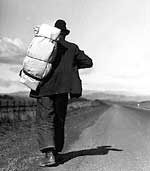
 Why
I should feel nostalgic for an era before my time, in a country I have
never li
Why
I should feel nostalgic for an era before my time, in a country I have
never li ved in, is difficult to define but is perhaps explained by the
emotions that Motion Pictures can engender. Films and newsreels of the
time have painted pictures of an America
still dusting itself down from Frontier
Days and with the hubris of youth looking up to see what's next up.
ved in, is difficult to define but is perhaps explained by the
emotions that Motion Pictures can engender. Films and newsreels of the
time have painted pictures of an America
still dusting itself down from Frontier
Days and with the hubris of youth looking up to see what's next up.